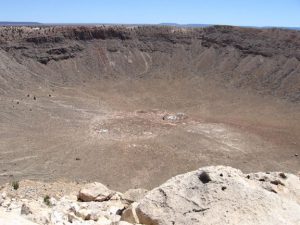It took me a while to get to sleep one night at the beginning of January. An angry younger self made an appearance, venting about her feelings of being unappreciated, mistreated, stressed out, and having to soldier on anyway. The triggering event was nothing more than a simple request for a copy of a document from that time period. I found it without any problems, but looking through my old files reminded me of a time when everything felt like a struggle.
After my past self went through her litany of grievances, and just before I fell asleep, I saw a mental image of a rocky, barren crater. It gave the impression that a meteor had blasted a deep hole in my emotional landscape many years ago, leaving a damaged area where nothing would grow.
(Creative Commons image via flickr)
“I’ll have to do something about this,” I told myself, before I finally dozed off. What that something might be was unclear, though. I couldn’t simply repair the damage by planting imaginary flowers and trees in that scarred landscape to represent abundance, or to screen off the view of the crater. All too plainly, my younger self wanted me to recognize the existence of the hurt, rather than prettying it up to hide it.
For the same reason, looking at the image from a great distance and telling myself that it was just an insignificant dip in the landscape, rather than an enormous crater, wouldn’t do. Although in fact I never experienced any actual disasters, the psyche has its own version of events, and its truth is not always literal. So the question then became: How could I honor the truth represented by the image of the crater, while not allowing old feelings of anger and hurt to take over my present-day life?
I gave the metaphor some thought. When a meteor hits, there is no malice behind it, no deliberate intent—in short, nobody to blame. A meteor is a random, destructive force of nature. Unlike our superstitious pagan ancestors, we don’t believe that a meteor strike is a punishment from the gods or an attack by evil spirits. Rather, it falls into the “stuff happens” category.
That does not mean it is insignificant or quickly forgotten. What does our modern-day culture typically do with a meteor crater? We wouldn’t fill it with truckloads of dirt and topsoil to restore the area to its previous condition (unless the damage impacts high-value urban real estate). Most often, the crater is left as it is and becomes a tourist attraction—maybe even a national monument. Visitors take photos with their mobile phones, tweet or blog about the unpredictable power of nature, and then go back to their everyday lives.
Looking at it from that perspective, I decided to construct some imaginary tourism infrastructure. That would help to show Younger-Me that she had only taken a day trip to Crater Monument and was not a prisoner trapped forever in a desolate, ruined wasteland.
So I visualized the crater again, this time with broad, well-maintained concrete walkways all around its perimeter. Railings gave protection from the steep slopes, and comfortable benches were placed at regular intervals. A little shop had snacks and souvenirs. There were trash cans and restrooms. Plaques attached to the railings welcomed visitors and described the crater’s history. A parking lot with bike racks and a bus shelter—where a tour bus had just pulled up—completed the scene, along with an access road.
“Okay, that’s all taken care of,” I declared briskly to Younger-Me, handing her a Sno-Cone from the snack shop. “Why don’t you sit down on that bench over there and relax for a while? It’s a hot day out here.”
She took the Sno-Cone without really noticing it, as she looked incredulously around at the much-changed landscape. I thought for a moment that she was going to burst out in uncontrollable laughter, but she stifled the impulse and turned back toward me instead. Finally, she summed up the unlikely scenario in a tone reminiscent of John McEnroe ranting at a hapless official on the tennis court.
“You can’t possibly be serious.”
I ate a few bites of my Sno-Cone before I answered. “Serious—well, that depends on how you look at it. Right now in real life, I’m looking out the window at a January snowstorm and wouldn’t at all mind trading it for a nice tourist spot somewhere hot. But, that doesn’t mean I would want to live there. Everything always changes, no matter how we might feel at the time.”
Although Younger-Me looked like she might have been about to say something more, she just glanced around one final time, shook her head in resignation, and sat down on the nearby bench. I thought I heard her muttering something about “consumer culture gone hog wild” as I faded out of her time.


Absolutely loved this post, Meg. So much to ponder about it…how you dealt with your YS. Many of us have craters or “dips” in the landscape that we need to incorporate into our lives.
Thanks much! Yes, even when the landscape may seem perfectly smooth, more of those “dips” always seem to turn up somewhere.